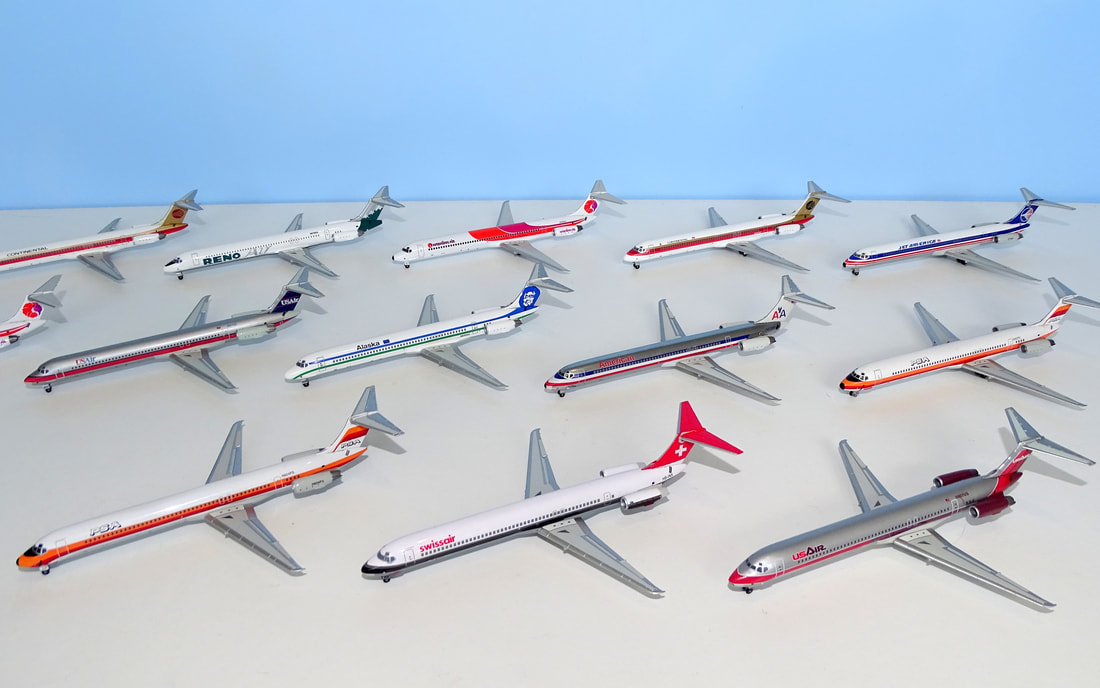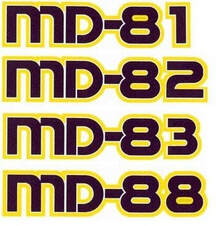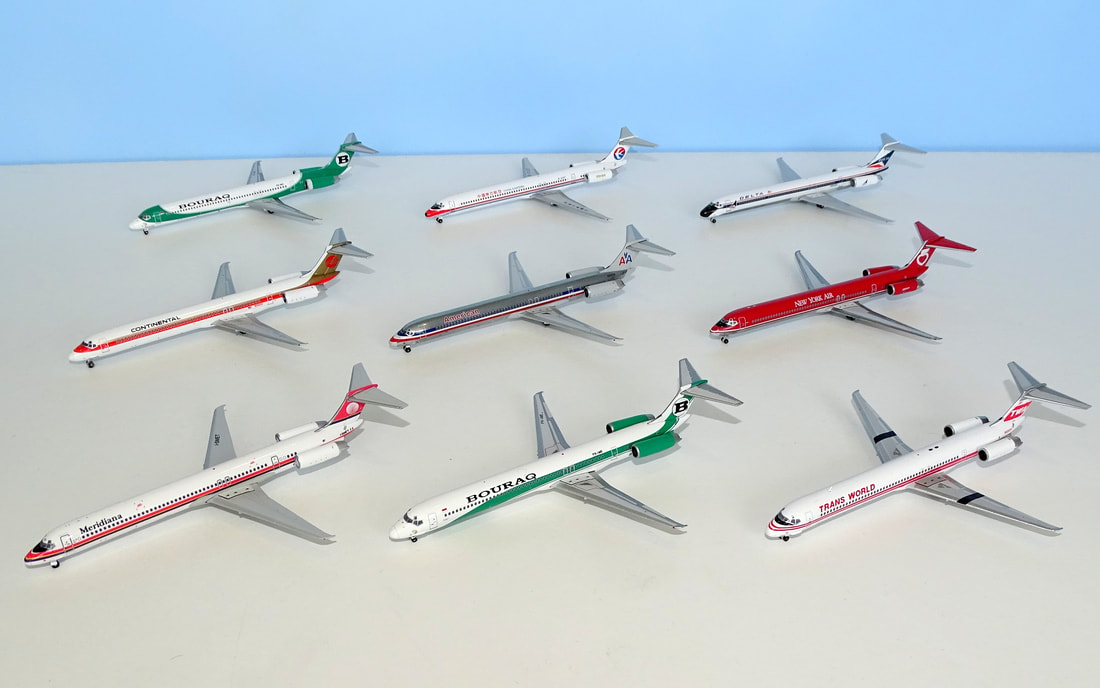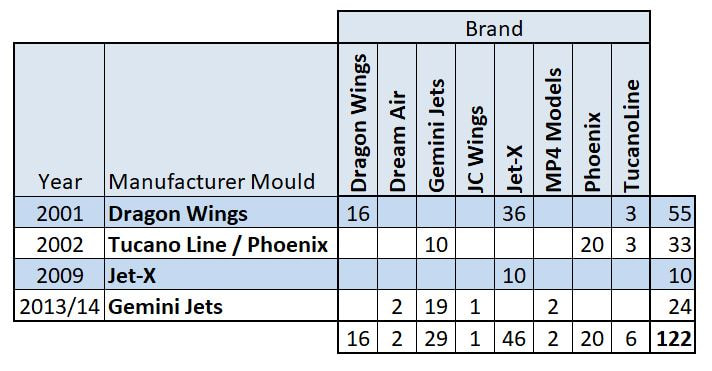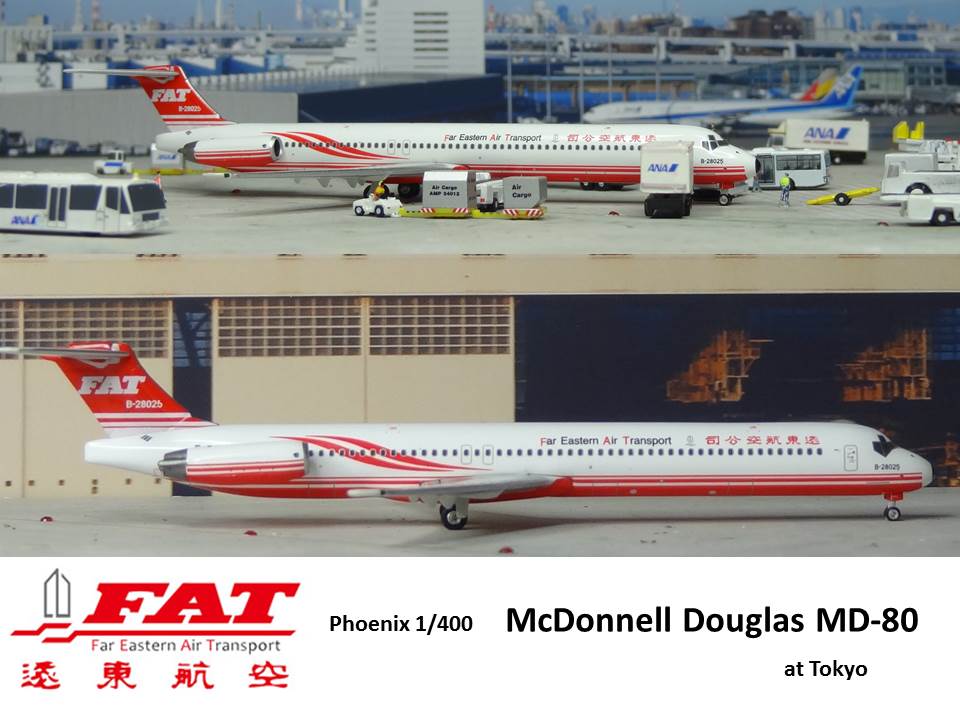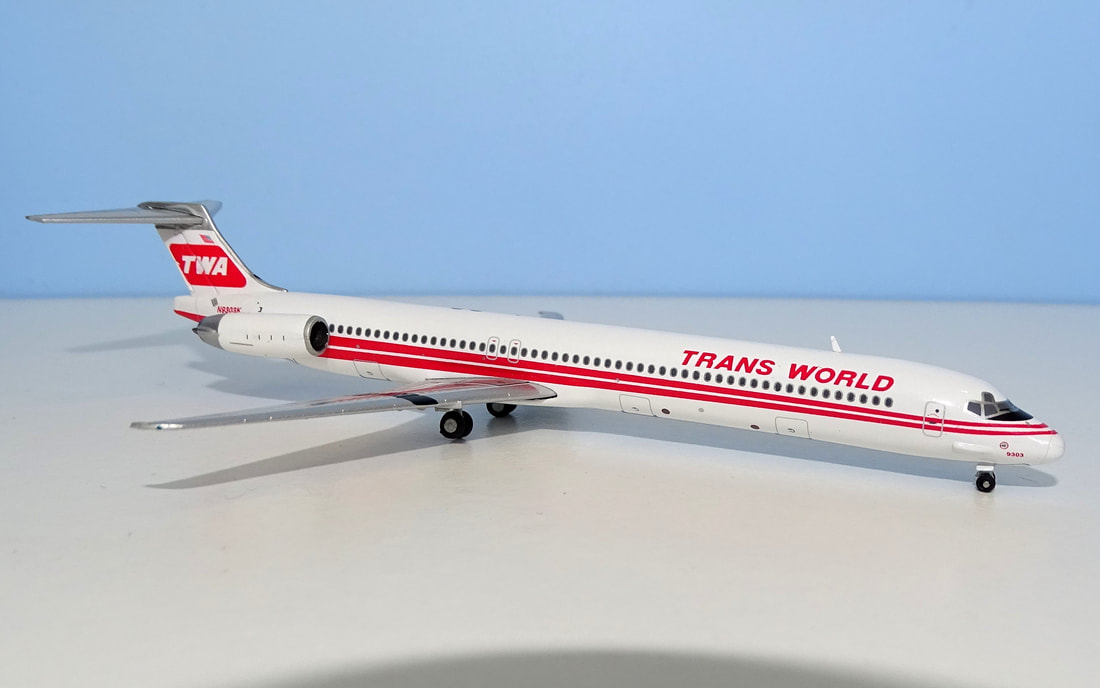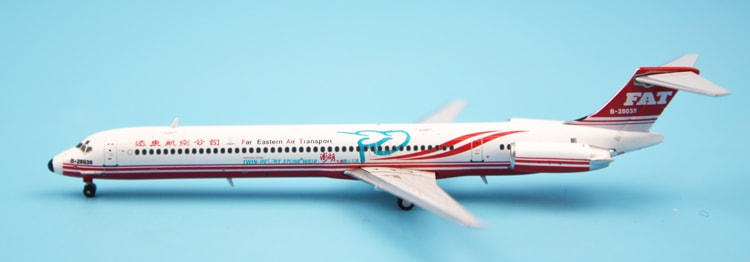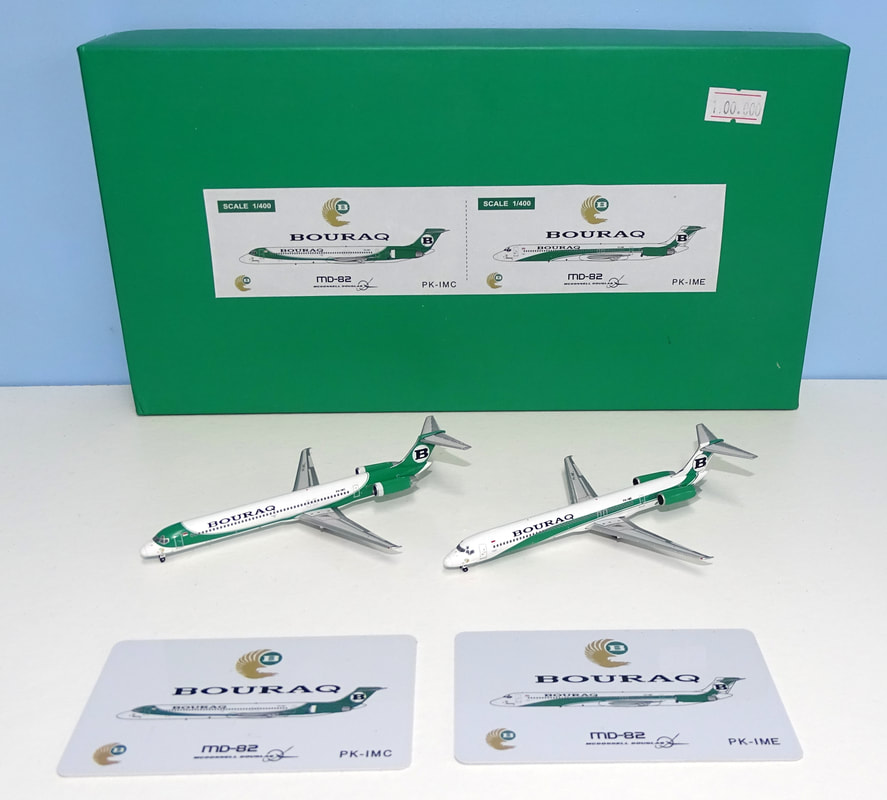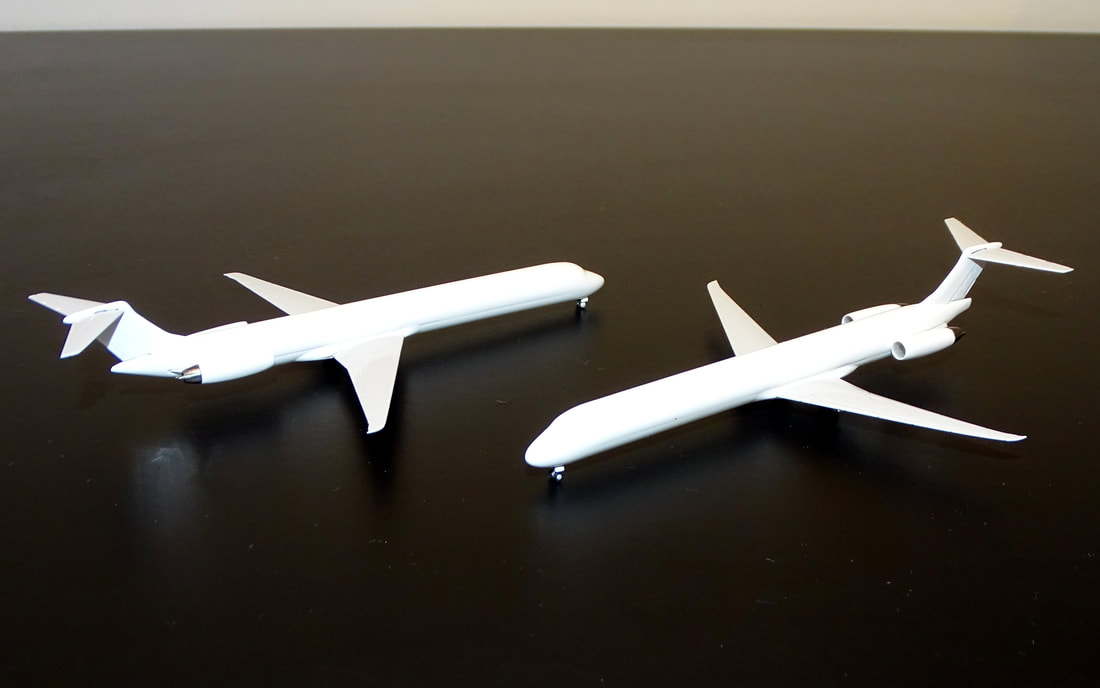Standard Body McDonnell Douglas MD-80s in 1/400 Scale
|
Updated: October 2023
|
|
|
The DC-9-80 (the marketing name MD-80 came into use in 1983 and DC-9-81s became MD-81s) was the natural result of stretching the already stretched DC-9-50 by a further 4.34m. As with the competing Boeing 757 it initially struggled to gain orders but a highly beneficial deal with and for American Airlines kickstarted orders and it competed well against the larger Boeing 757 and the smaller 737-300/400s prior to the A320 series making its mark. Service entry was with Swissair on October, 10 1980 and eventually 1,191 aircraft were built. The number in service has dwindled in recent years with both American Airlines retiring its last in 2019 and Delta its last in 2020. About 100 remain in service, with Iran proving to be a productive final home.
|
The MD-80 has been rather ignored by manufacturers with many obvious models missing (Delta Ron Allen, AirCal, Frontier, Muse Air, Continental globe, SAS, Alitalia, Finnair, Austrian, Airtours, Iberia etc etc etc). New MD-80 models are still released but it is a trickle rather than a flood. Hopefully the just announced NG Models MD-80s will change that situation for the better as there are literally hundreds of release options.
MD-81/82/83/88 in 1:400 Scale
There have been only 122 long body MD-80s released or announced in 400 scale as of mid-October 2023. The Dragon Wings mould is far and away the most used, but oddly a lot of its usage came from Jet-X and of those releases there was a lot of twinpacks and repetition, especially for Alaska Airlines, Hawaiian and PSA.
Note that later Jet-X (after it was taken over by Blue Box) developed its own MD-80 mould. Also note the mould sharing by Gemini Jets of the original Tucano / Phoenix mould, and more recently market retailer specific models for Dream Air of Taiwan and MP4 of Indonesia.
The breakdown of models by manufacturer and mould is as follows:
In Real Life
The marketing name MD-80 came into use in 1983 and DC-9-81s became MD-81s. The MD-82 and MD-83 were uprated variants with better engines and in the latter case greater fuel capacity. The MD-88 variant, which entered service in 1988, was a further updated MD-83 with a new cockpit, strengthened gear and other structural upgrades. All these variants share the same fuselage, however the MD-87 has a 5.28m shorter fuselage than a standard MD-80 and a fin extension above the tailplane (this variant is covered in a separate review).
Below is an early MD-82 with the original pointy tailcone:
Below is an early MD-82 with the original pointy tailcone:
The MD-87/88 also introduced the screwdriver rear fuselage type, which since late 1987 became the standard tail for all MD-80s and was retrofitted to many earlier examples. Here's an example with the screwdriver tailcone:
The Moulds
Dragon Wings (2001)
Jet-X and Dragon used to mould share a lot though the bulk of the 54 releases on this mould have been made by the former even though it was Dragon doing the design work. As with most Dragon moulds this early MD-80 has a one-piece fuselage with slot in wings, which means there are no ugly seam lines on the fuselage - though there is one where the horizontal stabilisers meet the tail. This mould has been the primary MD-80 version forever and despite its advanced age remains a solid, reliable and effective performer.
It isn't perfect and has several issues. The nosegear doors are too big but overall the nose shape is good. Likewise the horizontal stabilisers are not angled downward correctly but the tail is otherwise fine. Probably the most obvious problem is the engines. They are much too small. However, you only really tend to notice this when doing a direct comparison with a photo or other moulds, as their shape is fine. Another bonus for this mould is that there are two versions one with the original pointy tailcone and one with the screwdriver tail (see the Reno Air below). The screwdriver tail is actually not very good and doesn't really match the flat scalloped side of the real thing; the original cone however is very good.
Even with its issues this has been the mould to beat in the MD-80 range for many years, however it was mainly used for US airlines so available liveries are somewhat limited.
It isn't perfect and has several issues. The nosegear doors are too big but overall the nose shape is good. Likewise the horizontal stabilisers are not angled downward correctly but the tail is otherwise fine. Probably the most obvious problem is the engines. They are much too small. However, you only really tend to notice this when doing a direct comparison with a photo or other moulds, as their shape is fine. Another bonus for this mould is that there are two versions one with the original pointy tailcone and one with the screwdriver tail (see the Reno Air below). The screwdriver tail is actually not very good and doesn't really match the flat scalloped side of the real thing; the original cone however is very good.
Even with its issues this has been the mould to beat in the MD-80 range for many years, however it was mainly used for US airlines so available liveries are somewhat limited.
TucanoLine / Phoenix Mould (2002)
One year after Dragon another MD-80 mould appeared this time in the form of 3 releases from TucanoLine. From 2004 Phoenix tookover use of the mould (they were the effective successor of TucanoLine - see here for the backstory) and they released 18 models in 10 years. Between 2006 and 2014 Gemini borrowed the mould to make 10 essentially identical Allegiant releases.
The mould isn't awful but it isn't very good either! It is hamstrung by the nose shape, which appears too chunky and round. Early versions like this Crossair edition clearly show the undercarriage is also an issue with the mould. Rather than the slightly nose down look it ought to have the model has a slightly nose up aspect which looks weird. The horizontal stabilisers are not angled down enough and lastly the model has two seams - at the wing root and horizontal stabilisers. The mould only comes in a screwdriver tail version.
The mould isn't awful but it isn't very good either! It is hamstrung by the nose shape, which appears too chunky and round. Early versions like this Crossair edition clearly show the undercarriage is also an issue with the mould. Rather than the slightly nose down look it ought to have the model has a slightly nose up aspect which looks weird. The horizontal stabilisers are not angled down enough and lastly the model has two seams - at the wing root and horizontal stabilisers. The mould only comes in a screwdriver tail version.
In 2014 Phoenix replaced the ugly static gear with rolling gear which has improved the mould a little as can be seen from the FAT example below. I'm still not a fan and the fuselage still appears too level with no nose down attitude. This mould's not for me and appears to have fallen out of usage anyway.
New Jet-X Mould (2009)
In 2009 the new Jet-X, no longer associated with Dragon Wings and now owned by Blue Box - see here for the history, created its own MD-80. The mould appears ok except the nose appears to be too long and as with the Gemini/JC MD-90 below there appears some thickening of the lower fuselage moving forward ahead the wing. The nose length is possibly accentuated by Jet-X's regular issue of not printing the cockpit windows high enough - so they sometimes appear to be slipping down the nose. Otherwise the mould is not bad and at least has slot in wings and stabilisers. Jet-X released a small number of examples between 2009-2011 but the brand was discontinued by JC Wings and the mould vanished too. There are less airline releases than you might expect as Jet-X released both Chrome and Polished versions of the same model for their AA, Aeromexico and JAS releases. The mould does have the nose down aspect of the MD-80 however it looks like it may be a bit too nose down.
Gemini Jets Mould (2013) - Version 1
Gemini had apparently had an MD-80 in the works for a long time and its arrival in 2013 was much anticipated. Sadly the first release, American Airlines was very poor as it appears that something went wrong in the production of the model leaving the area forward of the wing, especially the nose, very variable.
Overall the rest of the mould is pretty good but the nose was awful. There is an obvious pinching in at the bottom by the front door. This looks weird and almost like two moulds have been cut and shut. This could also be the reason the mould is too low at the front. It makes the fuselage look fat! As others have mentioned the nose gear is too far back by at least half its width which makes the nose look too long. The overall effect from the side looks pretty bad.
Fortunately after this initial release the mould was retooled - see below.
Overall the rest of the mould is pretty good but the nose was awful. There is an obvious pinching in at the bottom by the front door. This looks weird and almost like two moulds have been cut and shut. This could also be the reason the mould is too low at the front. It makes the fuselage look fat! As others have mentioned the nose gear is too far back by at least half its width which makes the nose look too long. The overall effect from the side looks pretty bad.
Fortunately after this initial release the mould was retooled - see below.
Gemini Jets Mould (2014) Version 2
Fortunately it appears that the long break of over a year between the first MD-80 release and the second (both were AA releases) gave Gemini some time to fix the worst issues with the mould. The backend of the model is superb. The downward angle of the horizontal stabilizers at the top of the T tail is well finished, however the top of the tail is too angular and flat topped. The rest of the tail and rear fuselage is spot on and very importantly the engines are suitably chunky and well sized.
The shape of the underside of the nose is ok, although the nosegear is still too far backwards, kind of sits into the line of the body rather than against it and the gear doors are way too small. The biggest problems are on the top side of the nose. It is too pointy coming down from the cockpit, which itself is too sloping leaving the cockpit windows kind of pointing up rather than straight. The nose shape is inferior to the old Dragon mould and miles away from Aeroclassics superb DC-9 nose. Having said that it is still passable.
Both tailcone variants exist for the mould, although the screwdriver shape isn't spectacular.
The shape of the underside of the nose is ok, although the nosegear is still too far backwards, kind of sits into the line of the body rather than against it and the gear doors are way too small. The biggest problems are on the top side of the nose. It is too pointy coming down from the cockpit, which itself is too sloping leaving the cockpit windows kind of pointing up rather than straight. The nose shape is inferior to the old Dragon mould and miles away from Aeroclassics superb DC-9 nose. Having said that it is still passable.
Both tailcone variants exist for the mould, although the screwdriver shape isn't spectacular.
Usage of this mould has until recently been very low. Gemini have now made 19 examples but 4 of those have come in 2023 with the other 15 spread across 9 years! I've reviewed a recent TWA example here at the site:
Several versions have been made by JC Wings for retailers. These include a pair of Far Eastern Air Transport examples for Dream Air of Taiwan:
Another pair were made for MP4 models in indonesia as a twinpack. They are in the colours of Bouraq Indonesia:
Comparing the Dragon Mould with the Gemini Mould
Here are a series of shots showing the differences between the old Dragon mould (PSA) and the modified Gemini release (China Eastern). The size of the engines, angle of horizontal stabilisers, nose shape and height at rear are all obvious differences:
NG Models (2023)
It was a real surprise when NG Models told me they were sending me MD-80 samples for the 2023 AMS Aviation Fair. There are so many possibilities for them. Hopefully this time next year we will have seen a string of excellent Mad Dogs. The review of the samples is coming very soon.
